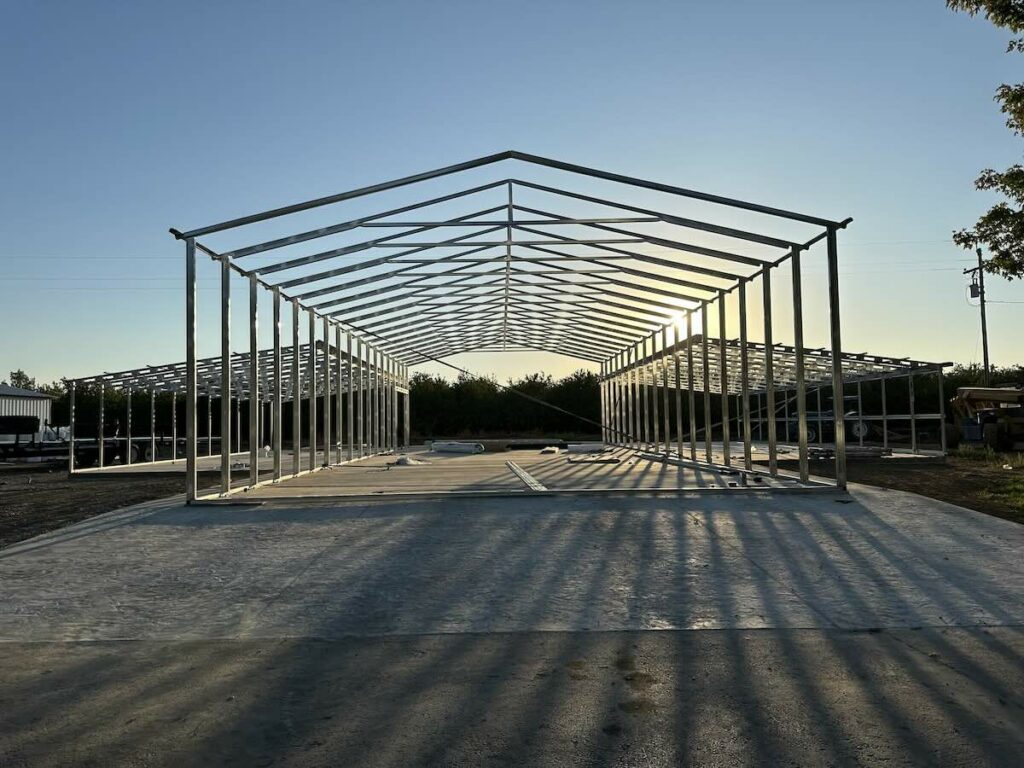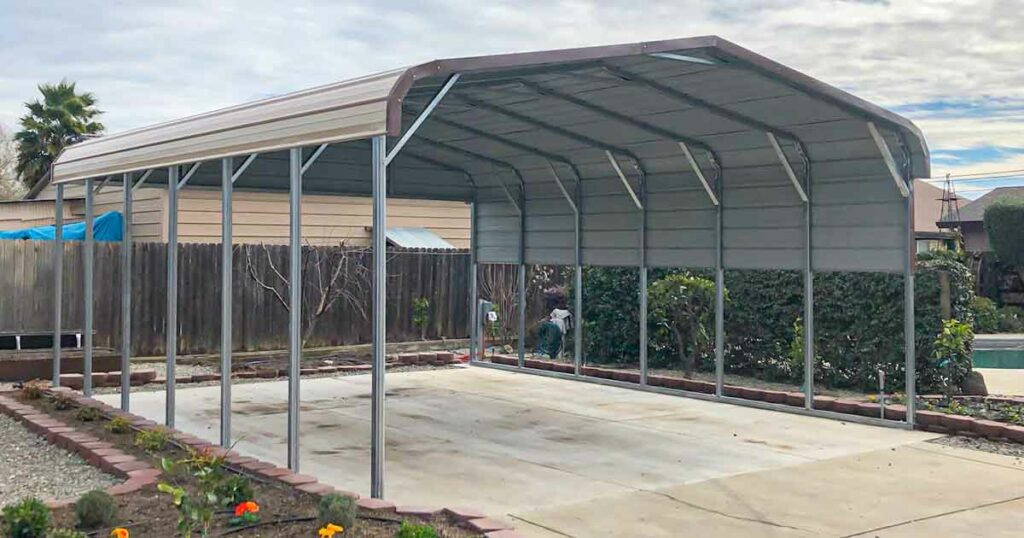When searching for carports you might come across terms that you may or may not recognize. This article is to give you a brief explanation of those terms.
Boxed-Eave Trim
Boxed Eve trim is used as a finishing touch on Box Eve-style structures. The trim provides a boxy look on the sides of the structure.
Base Rails
The square tubing on which the legs of the carport sit. Available in 12 gauge or 14 gauge steel.
Concrete Anchors
Anchors used in installations on concrete. Giving the warranty to 90-100 mile wind rate.
Corner Braces
Corner braces help reinforce the structure of the building or carport 4-two foot long corner braces come standard on all structures, and more are available at an additional cost.
Double Truss
Double trusses are used in our triple-wide structures, which begin at 26 feet to 30 feet wide and are designed to provide additional support.
Gable End
A Horizontal Panel that covers from the peak of the building to the eve of the building. Gable Ends can be installed Vertically at an additional cost.
Header
Headers are placed at the top of the door frame when an opening or garage door on the side is requested. They eliminate as many posts as needed. NOTE: They also take away the 1-foot height of clearance.
J-Trim
J-Trim is used as a decorative trim around walk-in doors, windows, vents, and to prevent injury from sharp edges.
L-Trim
L-Trim is used as decoration on the ends of Classical Style structures to provide a finished look. L-Trim is also used around the edges of garage doors and portions of the Boxed Eve-style structures.
Legs
Legs are the lengths of square tubing that elevate the top portion of the structure.
Windows
Optional window is 30” x 30”.
Walk-in Doors
The optional walk-in door size is 36” x 72”. Can also have 36″ x 80″ upon request.
Mobile-Home Anchors
30″ long Mobile home anchors are used strictly for ground installations. Giving the warranty to 90-100 mile wind rate.
Paneling
Paneling is 29-gauge steel and comes in standard lengths of 21’, 26’, and 31’ and in thirteen different colors (available at no additional cost).
Tubing
14-gauge square tubing comes standard but customers can upgrade and make the structure stronger by using 12-gauge square tubing. 12 gauge square tubing also comes with a 20-year rustproof warranty on the framing of the structure.
Rebar
Rebar anchors are approximately 3-foot-long pieces of rebar with a 5/8” nut welded on one end. Rebar anchors are used as temporary anchors.
Ridge Cap
Ridge caps are used on Vertical Style structure roofs only to cover the gap at the peak of the roof, where the separate roofing panels meet.
Truss
A truss is a single piece of square tubing bent to make the roof of a structure.
Gauge
Refers to the thickness of the metal; a lower gauge number indicates thicker metal.
Galvanization
A process of applying a protective zinc coating to steel or iron to prevent rusting.
R-Value
A measure of insulation’s ability to resist heat flow. Higher values indicate better insulation.
Trim
Decorative detailing is added to improve a carport’s appearance and protect against the elements
Anchor
Devices used to secure the carport to the ground or foundation.
Base Rail
The lowest horizontal support of a carport forms the base of the structure.
Bow
The curved pieces create the roof’s shape and provide support.
Bracing
Additional supports added to the structure for stability against wind and snow loads.
Certification
Indicates that a carport meets specific standards for load and resistance.
Eave Height
The vertical distance from the ground to the edge of the roof.
Fascia
A decorative trim or panel that covers the ends of the rafters and trusses.
Flashing
Material used to prevent water penetration at joints or edges.
Foundation
The underlying base or support for a carport, which can be concrete, asphalt, or even gravel.
Gable
The triangular portion of the end wall extends from the eaves to the peak of the roof.
Girt
Horizontal beams that provide lateral support to the walls.
Header
A horizontal support beam over openings such as doors or windows.
Lean-to
A type of carport attached to an existing structure, sharing one wall.
Leg Height
The height of the carport’s side from the ground to the eave.
Load
The weight the carport is designed to support, including snow, wind, and roof loads.
Mullion
A vertical or horizontal structural element that divides sections of the carport.
Purlin
Horizontal beams that support the roofing material.
Ridge Cap
A piece placed at the peak of the roof to seal the joint between two sloping roof sections.
Sectional Overhead Doors
Garage-style doors that open vertically and are made of several panels.
Skylights
Window-like openings in the roof for daylight.
Slope
The angle of the roof, usually represented as a ratio of vertical rise to horizontal run.
Snow Load
The weight of snow the roof is designed to handle.
Span
The distance between two supporting structures.
Square Footage
The total surface area within the carport’s perimeter.
Studs
Vertical supports in the wall framing.
Truss
A framework, typically triangular, that supports the roof.
Turnbuckle Braces
Adjustable braces used to maintain tension and stability.
Vapor Barrier
Material used to prevent moisture from penetrating walls or roofs.
Ventilation
Systems or features designed to allow airflow within the carport.
Wainscoting
A paneling is applied to the lower part of the walls for aesthetic or protective purposes. This can be a different color to add contrast to your bui,ding design.
Wall Height
The vertical distance from the base rail to the top of the wall panel.
Weather Stripping – Material used to seal gaps around doors and windows against the elements.
Wind Load
The force exerted by the wind on the carport.
Z-Braces
Diagonal braces are designed to add rigidity to door panels.
Foundation Anchors
Anchors are used specifically to secure the carport to a foundation.
Insulation Kit
Pre-packaged materials used to insulate a carport for thermal efficiency.
Peak Height
The highest point of the carport, measured from the ground.
Pitch
Another term for the slope of the roof and indicates its steepness.
Roll-up Door
A door that opens by rolling up on itself, commonly used in commercial applications. The garage doors roll up into a cylinder above the opening rather than pulled back along a track.
Sidewall
The vertical walls on the sides of the carport.



